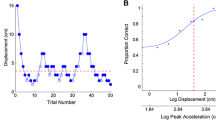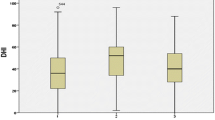Abstract
There exists no functional guide that can serve as a diagnostic tool for individual susceptibility to motion sickness (MS). We evaluated vestibular system functioning via a caloric test (which assesses functioning of the superior vestibular nerve) and the vestibular-evoked myogenic potentials (VEMP) test (which assesses inferior vestibular nerve functioning) in 20 MS susceptible and 20 nonsusceptible individuals. Susceptibility to MS was determined by self-declaration and with MS susceptibility questionnaire and Hamilton Anxiety Scale (HAS). We found statistically significant differences for scores on the MS susceptibility questionnaire and HAS questionnaire; however, we found no correlation between VEMP and caloric test results. We suggest that VEMP and caloric test results are not affected by individuals’ susceptibility to MS. We could not find vestibular system deficits using the VEMP and caloric test combination. Our findings do not support vestibular function asymmetry in MS patients.


Similar content being viewed by others
References
Money KE (1990) Motion sickness and evaluation. In: Crampton GH (ed) Motion and space sickness. CRC Press, Boca Raton, pp 1–9
Yates BJ, Miller AD, Lucot JB (1998) Physiological basis and pharmacology of motion sickness: an update. Brain Res Bull 47:395–406. doi:10.1016/S0361-9230(98)00092-6
Tal D, Hershkovitz D, Kaminski G et al (2006) Vestibular evoked myogenic potential threshold and seasickness susceptibility. J Vestib Res 16:273–278
Tal D, Gilbey P, Bar R et al (2007) Seasickness pathogenesis and the otolithic organs: vestibular evoked myogenic potentials study—preliminary results. Isr Med Assoc J 9:641–644
Heer M, Paloski WH (2006) Space motion sickness: incidence, etiology, and countermeasures. Auton Neurosci 129:77–79. doi:10.1016/j.autneu.2006.07.014
Yokota Y, Aoki M, Mizuta K et al (2005) Motion sickness susceptibility associated with visually induced postural instability and cardiac autonomic responses in healthy subjects. Acta Otolaryngol 125:280–285. doi:10.1080/00016480510003192
Owen N, Leadbetter AG, Yardley L (1998) Relationship between postural control and motion sickness in healthy subjects. Brain Res Bull 47:471–474. doi:10.1016/S0361-9230(98)00101-4
Evans RW, Marcus D, Furman JM (2007) Motion sickness and migraine. Headache 47:607–610
Golding JF (2006) Motion sickness susceptibility. Auton Neurosci 129:67–76. doi:10.1016/j.autneu.2006.07.019
Bos JE, Bles W (1998) Modelling motion sickness and subjective vertical mismatch detailed for vertical motions. Brain Res Bull 47:537–542. doi:10.1016/S0361-9230(98)00088-4
Bles W, Bos JE, de Graaf B et al (1998) Motion sickness: only one provocative conflict? Brain Res Bull 47:481–487. doi:10.1016/S0361-9230(98)00115-4
Bles W, Bos JE, Kruit H (2000) Motion sickness. Curr Opin Neurol 13:19–25. doi:10.1097/00019052-200002000-00005
Flanagan MB, May JG, Dobie TG (2004) The role of vection, eye movements and postural instability in the etiology of motion sickness. J Vestib Res 14:335–346
Shupak A, Kerem D, Gordon C et al (1990) Vestibulo-ocular reflex as a parameter of seasickness susceptibility. Ann Otol Rhinol Laryngol 99:131–136
Gordon CR, Spitzer O, Doweck I et al (1996) The vestibulo-ocular reflex and seasickness susceptibility. J Vestib Res 6:229–233. doi:10.1016/0957-4271(95)02011-X
Clément G, Deguine O, Bourg M et al (2007) Effects of vestibular training on motion sickness, nystagmus, and subjective vertical. J Vestib Res 17:227–237
Shahal B, Nachum Z, Spitzer O et al (1999) Computerized dynamic posturography and seasickness susceptibility. Laryngoscope 109:1996–2000. doi:10.1097/00005537-199912000-00019
Gordon CR, Ben-Aryeh H, Spitzer O et al (1994) Seasickness susceptibility, personality factors, and salivation. Aviat Space Environ Med 65:610–614
Radtke A, Popov K, Bronstein AM et al (2003) Vestibulo-autonomic control in man: short- and long-latency vestibular effects on cardiovascular function. J Vestib Res 13:25–37
Doweck I, Gordon CR, Shlitner A et al (1997) Alterations in R–R variability associated with experimental motion sickness. J Auton Nerv Syst 67:31–37. doi:10.1016/S0165-1838(97)00090-8
Golding JF, Kadzere P, Gresty MA (2005) Motion sickness susceptibility fluctuates through the menstrual cycle. Aviat Space Environ Med 76:970–973
Eversmann T, Gottsmann M, Uhlich E et al (1978) Increased secretion of growth hormone, prolactin, antidiuretic hormone, and cortisol induced by the stress of motion sickness. Aviat Space Environ Med 49:53–57
Stern RM, Koch KL, Leibowitz HW et al (1985) Tachygastria and motion sickness. Aviat Space Environ Med 56:1074–1077
Balaban CD (1999) Vestibular autonomic regulation (including motion sickness and the mechanism of vomiting). Curr Opin Neurol 12:29–33. doi:10.1097/00019052-199902000-00005
Miller DA (1991) Motion indused nausea and vomiting. In: Kucharczyk J, Stewart DJ, Miller DA (eds) Nausea and vomiting: recent research and clinical advances. CRC Press, Cleveland, pp 13–43
Bos JE, Bles W, Groen EL (2007) A theory on visually induced motion sickness. Displays (2007), doi:10.1016/j.displa.2007.09.002 (in press)
Yates BJ (1998) Autonomic reaction to vestibular damage. Otolaryngol Head Neck Surg 119:106–112. doi:10.1016/S0194-5998(98)70179-2
Brizzee KR, Igarashi M (1986) Effect of macular ablation on frequency and latency of motion-induced emesis in the squirrel monkey. Aviat Space Environ Med 57:1066–1070
Iwasaki S, Takai Y, Ozeki H et al (2005) Extent of lesions in idiopathic sudden hearing loss with vertigo: study using click and galvanic vestibular evoked myogenic potentials. Arch Otolaryngol Head Neck Surg 131:857–862. doi:10.1001/archotol.131.10.857
Wuyts FL, Furman J, Vanspauwen R et al (2007) Vestibular function testing. Curr Opin Neurol 20:19–24. doi:10.1097/WCO.0b013e3280140808
Murofushi T, Halmagyi GM, Yavor RA et al (1996) Absent vestibular evoked myogenic potentials in vestibular neurolabyrinthitis. An indicator of inferior vestibular nerve involvement? Arch Otolaryngol Head Neck Surg 122:845–848
Murofushi T, Matsuzaki M, Wu CH (1999) Short tone burst-evoked myogenic potentials on the sternocleidomastoid muscle: are these potentials also of vestibular origin? Arch Otolaryngol Head Neck Surg 125:660–664
Murofushi T, Matsuzaki M, Mizuno M (1998) Vestibular evoked myogenic potentials in patients with acoustic neuromas. Arch Otolaryngol Head Neck Surg 124:509–512
Seo T, Miyamoto A, Node M et al (2008) Vestibular evoked myogenic potentials of undiagnosed dizziness. Auris Nasus Larynx 35:27–30. doi:10.1016/j.anl.2007.04.006
Wit HP, Kingma CM (2006) A simple model for the generation of the vestibular evoked myogenic potential (VEMP). Clin Neurophysiol 117:1354–1358. doi:10.1016/j.clinph.2006.03.014
Palomar-Asenjo V, Boleas-Aguirre MS, Sánchez-Ferrándiz N et al (2006) Caloric and rotatory chair test results in patients with Ménière’s disease. Otol Neurotol 27:945–950. doi:10.1097/01.mao.0000231593.03090.23
Golding JF (1998) Motion sickness susceptibility questionnaire revised and its relationship to other forms of sickness. Brain Res Bull 47:507–516. doi:10.1016/S0361-9230(98)00091-4
Sheehan DV, Sheehan K (1990) What structured interviews are available? In: Sartorius N (ed) Anxiety: psychobiological and clinical perspectives. Taylor & Francis, London, pp 86–97
Arriaga MA, Chen DA, Cenci KA (2005) Rotational chair (ROTO) instead of electronystagmography (ENG) as the primary vestibular test. Otolaryngol Head Neck Surg 133:329–333. doi:10.1016/j.otohns.2005.05.002
Welgampola MS, Colebatch JG (2001) Vestibulocollic reflexes: normal values and the effect of age. Clin Neurophysiol 112:1971–1979. doi:10.1016/S1388-2457(01)00645-9
Ozluoglu LN, Akkuzu G, Ozgirgin N et al (2008) Reliability of the vestibular evoked myogenic potential test in assessing intratympanic gentamicin therapy in Meniere’s disease. Acta Otolaryngol 128:422–426. doi:10.1080/00016480701808988
Akkuzu G, Akkuzu B, Ozluoglu LN (2006) Vestibular evoked myogenic potentials in benign paroxysmal positional vertigo and Meniere’s disease. Eur Arch Otorhinolaryngol 263:510–517. doi:10.1007/s00405-005-0002-x
Zhou G, Gopen Q, Kenna MA (2008) Delineating the hearing loss in children with enlarged vestibular aqueduct. Laryngoscope (Jul):25 Epub ahead of print
Hong SM, Yeo SG, Kim SW et al (2008) The results of vestibular evoked myogenic potentials, with consideration of age-related changes, in vestibular neuritis, benign paroxysmal positional vertigo, and Meniere’s disease. Acta Otolaryngol 128:861–865. doi:10.1080/00016480701784981
Felipe L, Gonçalves DU, Santos MA et al (2008) Vestibular-evoked myogenic potential (VEMP) to evaluate cervical myelopathy in human T-cell lymphotropic virus type I infection. Spine 33:1180–1184
Lin MY, Timmer FC, Oriel BS et al (2006) Vestibular evoked myogenic potentials (VEMP) can detect asymptomatic saccular hydrops. Laryngoscope 116:987–992. doi:10.1097/01.mlg.0000216815.75512.03
Perez N, Rama-Lopez J (2005) Vestibular function at the end of intratympanic gentamicin treatment of patients with Ménière’s disease. J Vestib Res 15:49–58
Düwel P, Ilgner J, Engelke JC et al (2004) Subclassification of vestibular disorders by means of statistical analysis in caloric labyrinth testing. Acta Otolaryngol 124:595–602. doi:10.1080/00016480310015182
von Baumgarten RJ, Thumler R (1979) A model for vestibular function in altered gravitational states. Life Sci Space Res 17:161–170
Nachum Z, Shupak A, Letichevsky V et al (2004) Mal de debarquement and posture: reduced reliance on vestibular and visual cues. Laryngoscope 114:581–586. doi:10.1097/00005537-200403000-00036
Reschke MF, Anderson DJ, Homick JL (1984) Vestibulospinal reflexes as a function of microgravity. Science 225:212–214. doi:10.1126/science.6729475
Zupan L, Peterka R, Merfeld D (2000) Neural processing of gravitoinertial cues in humans. I. Influence of the semicircular canals following postrotatory tilt. J Neurophysiol 84:2001–2015
Merfeld DM, Zupan LH (2002) Neural processing of gravitoinertial cues in humans. III. Modeling Tilt and Translation Responses. J Neurophysiol 87:819–833
Parker DE (1998) The relative roles of the otolith organs and semicircular canals in producing space motion sickness. J Vestib Res 8:57–59. doi:10.1016/S0957-4271(97)00039-6
Merfeld DM, Zupan LH, Gifford CA (2001) Neural processing of gravitoinertial cues in humans. II. Influence of the semicircular canals during eccentric rotation. J Neurophysiol 85:1648–1660
Merfeld D, Zupan L, Peterka R (1999) Humans use internal models to estimate gravity and linear acceleration. Nature 398:615–618. doi:10.1038/19303
Mallinson AI, Longridge NS (2002) Motion sickness and vestibular hypersensitivity. J Otolaryngol 31:381–385. doi:10.2310/7070.2002.34575
Acknowledgments
We would like to thank the volunteers in this study, the medical students Arinc İkiz, Mert Basaran, Merve Dirikoc, and Kadirhan Akyol from Baskent University for their assistance, the audiometrists at our clinic for their technical support, and Dr. Elif Durukan from the Department of Public Health, Baskent University, for statistical analysis. This research was supported by a grant, No. KA07/206, from the Baskent Research Foundation.
Author information
Authors and Affiliations
Corresponding author
Rights and permissions
About this article
Cite this article
Buyuklu, F., Tarhan, E. & Ozluoglu, L. Vestibular functions in motion sickness susceptible individuals. Eur Arch Otorhinolaryngol 266, 1365–1371 (2009). https://doi.org/10.1007/s00405-009-0927-6
Received:
Accepted:
Published:
Issue Date:
DOI: https://doi.org/10.1007/s00405-009-0927-6




